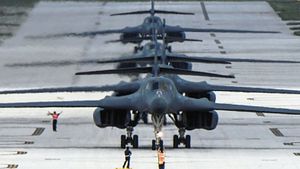On July 4th North Korea demonstrated an ICBM capable of reaching Alaska, and on the 28th, it demonstrated that that same missile could reach even further, possibly into the heartland of the United States. The launches effectively announced that North Korea possessed an imminently operational nuclear deterrent with which to threaten the United States itself, and not just its allies in Northeast Asia.
After both missile tests the United States responded with similar military demonstrations – flights of B-1 bombers around the Korean Peninsula and live-fire missile exercises with the South Korean military. These responses demonstrated an implicit counterforce capability – the ability to neutralize North Korea’s nuclear missiles before they can be launched – but simultaneously show how few new tools the United States has to manage North Korea’s behavior.
Three days after the July 4th test, two U.S. B-1 bombers flew from their base on Guam and dropped inert training bombs on a range in South Korea while escorted by South Korean fighter jets. On their return flight back to Guam the bombers were escorted by Japanese fighter jets. A day after North Korea’s July 28th test, two B-1s flew a similar mission, this time being joined by Japanese fighters while en route to the Korean peninsula before picking up South Korean escorts. No training ordnance was reported dropped on this mission.
The United States has responded to North Korean tests with B-1 flights before, and uses bombers as signaling tools in Asia more commonly. What was more unusual was the live-fire demonstrations of the U.S. Army’s Army Tactical Missile System (ATACM) and South Korea’s Hyunmoo II missile following both North Korean ICBM tests. Both the ATACM and the Hyunmoo II are short-range ballistic missiles – the ATACM has a 300 km range and Hyunmoo II variants have ranges between 300 and 800 kilometers – designed to provide ground forces with longer precision reach than traditional artillery systems.
Together, the B-1 flights and ATACM exercises demonstrate U.S. conventional counterforce capabilities that it might use against North Korean nuclear missiles.
The concept of counterforce evolved during the Cold War when the United States and Soviet Union sought ever more, and more advanced, nuclear capabilities specifically targeted to neutralize the other’s nuclear arsenals before they could be used. But the leaps in precision targeting and the relatively short ranges involved in the Korean peninsula suggest the possibility of conducting counterforce strikes against North Korean nuclear targets with conventional weapons.
While commonly described as a nuclear bomber, the B-1’s ability to carry nuclear weapons was removed under the terms of the START arms control treaty. But even with its nuclear mission gone, as a supersonic, low radar-observable heavy bomber originally designed to penetrate heavily defended Soviet airspace, it would be a likely choice to conduct precision strikes against North Korean nuclear targets like mobile missiles or production facilities.
U.S. Forces Korea described the potential counterforce mission of the ATACMS and Hyunmoo II more explicitly, emphasizing the missiles’ “deep strike precision capability” against “time critical targets” – like North Korea’s mobile ICBM launchers – in any weather conditions.
Despite the stronger counterforce message sent by combining B-1 missions with missile exercises, there remains a problematic asymmetry in the U.S. responses to North Korea’s missile tests.
Each of North Korea’s successful tests demonstrates a new or improved capability – most recently the ability to deliver a nuclear weapon to the continental United States. By contrast, the U.S. responses have showcased counterforce capabilities that are significant but not new. It is possible that the United States’ B-1s and ATACMS are adequate to neutralize not just North Korea’s newest nuclear missiles before they can be launched, but can also defeat any anticipated North Korean measures to protect or proliferate them.
But even so, repeatedly demonstrating the same capability while North Korea demonstrates new capabilities may contribute to an impression that the United States is failing to keep up with the threat posed by North Korea’s missile and weapon technology. That sense of not keeping up may then stoke political momentum for stronger responses.
Since the United States has now established a pattern by responding to North Korea’s ICBM tests with a combination of B-1 and missile exercises, it would be unlikely that any future ICBM tests would be met with only one or the other responses, lest it were interpreted as a softening of U.S. resolve or a wavering of commitment to its allies. The United States’ incentive is instead to either to add complexity to those demonstrations, or reveal a new capability. But unless an arrangement can be reached that would freeze North Korea’s burgeoning ballistic missile program, eventually the gap between what the United States can demonstrate and the new capabilities that North Korea demonstrates will become so great as to be politically untenable and the two countries will find themselves on the precipice of armed clash, with a potential for nuclear escalation.

































